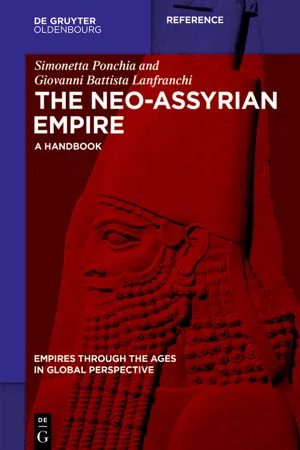
- 668 pages
- English
- ePUB (mobile friendly)
- Available on iOS & Android
About this book
The ancient historians considered the Assyrian empire the crucial starting point of a new political system which was adopted by later empires. In modern historical research, this problem still needs to be investigated in a global perspective that studies the development of the imperial model through ages. Abundant epigraphical and archaeological sources can be used in investigating the expansionistic tacticts, the control structures, and the administrative procedures implemented by the Assyrians through a continuous effort of adaptation to evolving situations and changing needs. The book provides an updated outline of the history of the Assyrian empire and its neighbours, a detailed analysis of the technical and ideological aspects of the construction of the Assyrian empire, and of its long-lasting legacy in the Near East and in the West. For its broad theoretical framework, which includes the reference to studies of ancient and modern empires and imperialism, the book is intended not only for the specialists of Ancient Near Eastern history, but also for a wider public of Classical and Medieval historians and of historians interested in world and global history.
Frequently asked questions
- Essential is ideal for learners and professionals who enjoy exploring a wide range of subjects. Access the Essential Library with 800,000+ trusted titles and best-sellers across business, personal growth, and the humanities. Includes unlimited reading time and Standard Read Aloud voice.
- Complete: Perfect for advanced learners and researchers needing full, unrestricted access. Unlock 1.4M+ books across hundreds of subjects, including academic and specialized titles. The Complete Plan also includes advanced features like Premium Read Aloud and Research Assistant.
Please note we cannot support devices running on iOS 13 and Android 7 or earlier. Learn more about using the app.
Information
Table of contents
- Title Page
- Copyright
- Contents
- Principles of Transcription
- Introduction
- 1 The Sources
- 2 Narrating the Empire with Images: Assyrian Narrative Art
- 3 An Overview of the Middle Assyrian Period
- 4 Socio-political Landscapes from the Late 11th to the Early 8th Century bce
- 5 The Rise of Assyria as a Supraregional Power (from Aššur-dan II to Ashurnasirpal II)
- 6 The Imperial Construction (from Shalmaneser III to Aššur-nirari V)
- 7 Tiglath-pileser III (745 – 727 bce)
- 8 Sargon (721 – 705 bce)
- 9 Sennacherib (705 – 681 bce)
- 10 Esarhaddon (680 – 669 bce)
- 11 Ashurbanipal (668 – 630? bce)
- 12 The Epilogue
- 13 The Urban Landscape
- 14 The Rural Landscape
- 15 The System of Power and Governance
- 16 Gods, Kings and Empire
- 17 Scribal Culture and Sciences
- 18 The Aftermath: Interpretations, Memories and a Complex Legacy
- 19 The Assyrian “Empire”
- Appendix
- 2) Literature
- Indices